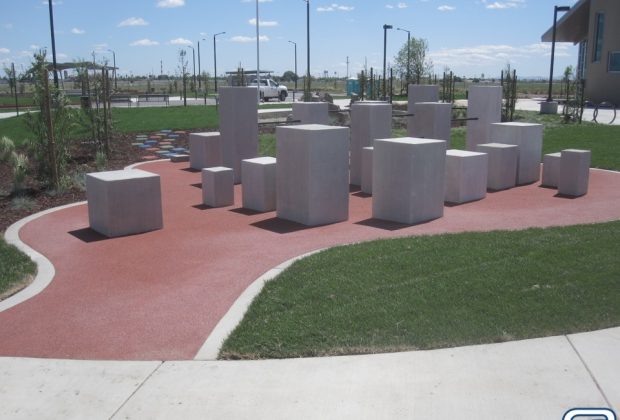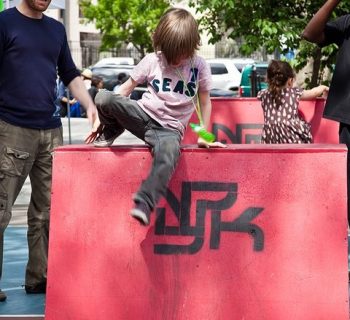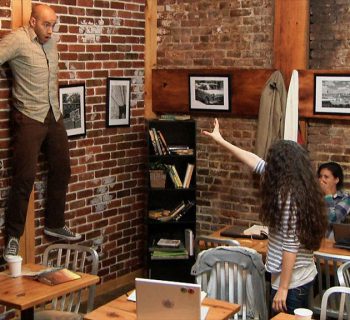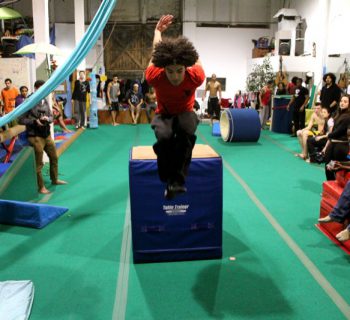We've come a long way as a community and quite a few building blocks with one such as the U.K. recognizing Parkour as sport is one of the most important ones. This article is about the urgency of America catching up so that we can make Parkour mainstream enough to want to be safer with train. With the mainstream of the sport on the rise, luckily that would mean for us practitioners more parks than we can imagine outside.
————————————
We Should Be Building More Parkour Parks
The U.K. government recently recognized parkour as a legitimate sport, and is bringing parks to inner cities, schools, and even senior citizens. Why hasn't the U.S. gotten on board?
While technically impressive, parkour—the act of running and jumping over things—is fundamentally silly looking. Its main practitioners, if YouTube is any indicator, are shirtless young men with mild Red Bull addictions. Online, videos of these free running bros failing to stick their risky jumps rack up the views. From afar, the activity manages to feel both fringe and uncool at the same time—as if skateboarding had skipped its counterculture heyday and gone straight into suburban malaise.
But that's not the case in the UK, where the sport has a firm foothold. Here’s a surprising statistic: more than a third of parkour’s participants in the U.K. are female. A full half are people of color. In cities, where the activity is most popular, parkour courses for families and “forever young” parkour-inspired classes for seniors fill up regularly. As a result, last month England became the first country in the world to officially recognize parkour as a sport. The recognition puts parkour—a seemingly unorganized pursuit that’s traditionally been associated with risk-taking and public nuisance—on the same level as football (soccer), rugby, and cricket, and ensures it access to government funding.
Mockable as parkour’s Youtube stars may be, the Brits have good reason for their recognition. A January reportfrom the government’s Department for Culture, Media, and Sport showed that almost 100,000 Britons over 16 years old participated in parkour twice in the previous 28 days—significantly more than the number who skateboarded (47,900), wrestled (23,200), or trained for a triathlon (25,400) or an obstacle course race (14,700). Although the government doesn’t track youth participation, parkour is particularly attractive to kids, organizers say. For disadvantaged children, it’s a free way to exercise and explore the outdoors. Local governments in the U.K. have been teaching at-risk youth parkour for almost a decade and have observed a 69 percent reduction in crime in those areas. (It’s unclear whether there’s clear causation between the two.)
“There’s a misconception you get with parkour that it’s just young men who like to jump around,” says Eugene Minogue, the current head of Parkour U.K., the national governing body for the sport in Britain. “But Parkour is extremely accessible. You just need a pair of trainers”—British for sneakers—“and your imagination. You don’t need a special place to do it or any kit. Parkour allows me to stick a few fingers up”—the limey equivalent to flipping the bird—“to the establishment,” he says.
So if parkour is such a cheap and effective way to get kids exercising outdoors, why aren’t more Americans doing it?
The second reason is infrastructure: the U.K. now has 50 purpose-built parkour parks, Minogue says, while the U.S. has one permanent (but underwhelming) park, tacked on to a skate park in Central California, and two or so more on the way—one in Boise, and another in a location to-be-determined. Though participation numbers in the U.S. don’t exist, Evitts estimates “tens of thousands” of Americans currently participate.
Another problem is logistical: there is no one dominant parkour organization in the U.S. Instead several disparate groups run gyms and train coaches independently. There’s no governmental department like the U.K.’s sports ministry to bestow official recognition and dole out funds to facilitate the sport’s growth.
But the most serious difference between parkour in Europe and America is legal. “Liability is a big concern here,” Evitt says. “Take Denmark for example. If you’re jumping on a wall and you fall off that wall, it’s seen as your fault—you’re responsible for your actions. In the U.S., we’re very good at shifting the blame to someone else, whether that’s the landowner or the city or whoever—it’s not your own fault. That’s something people are very aware of here.”
The result is a distinct change in the way parkour is practiced in the U.S. “Around 2008 or 2009, the first parkour gyms started opening up here,” says Colin MacDonald of Parkour Visions, a Seattle parkour nonprofit that’s working to get parkour parks built around the country. “I think that’s been the huge difference between the U.S. and the rest of global parkour. The U.S. is very gym-focused. Those first few gyms became hubs of our parkour culture.”
Today, every big city in America has a parkour gym or three. Participants pay to attend and learn the practice from coaches in controlled environments. Many of the gyms try to recreate the feel and look of moving in urban environment—most surfaces are hard and padding isn’t ubiquitous—but it’s a different experience from hopping rails on the south bank of the Thames in London. “I think it changes [parkour], unquestionably,” MacDonald says. “It changes the way people approach it, changes what people look to as their goals.”
Practicing parkour indoors doesn’t make it any less of a sport, but it does make it less accessible. To make parkour attainable for kids and others, schools like New York’s Movement Creative have opened up free park outdoor parkour parks in the summer.
Despite the speedbumps, Evitt is confident the number of American parkour participants will continue to climb. That’s because parkour, whether you notice it or not, has quietly become mainstream. Ninja Warrior competitions are essentially big parkour-fests. Any action movie you watch is filled with parkour stunts. “Captain America is essentially a parkour athlete,” Evitt says. That’s probably because the sport harkens back to something basic about movement and exercise.
“Everybody wants to be back outdoors,” Parkour U.K.’s Minogue says. “It’s getting back to human instinct. We’re all born to move. People say to me, ‘How do I start parkour?’ I say, ‘The answer is when did you stop?’”







